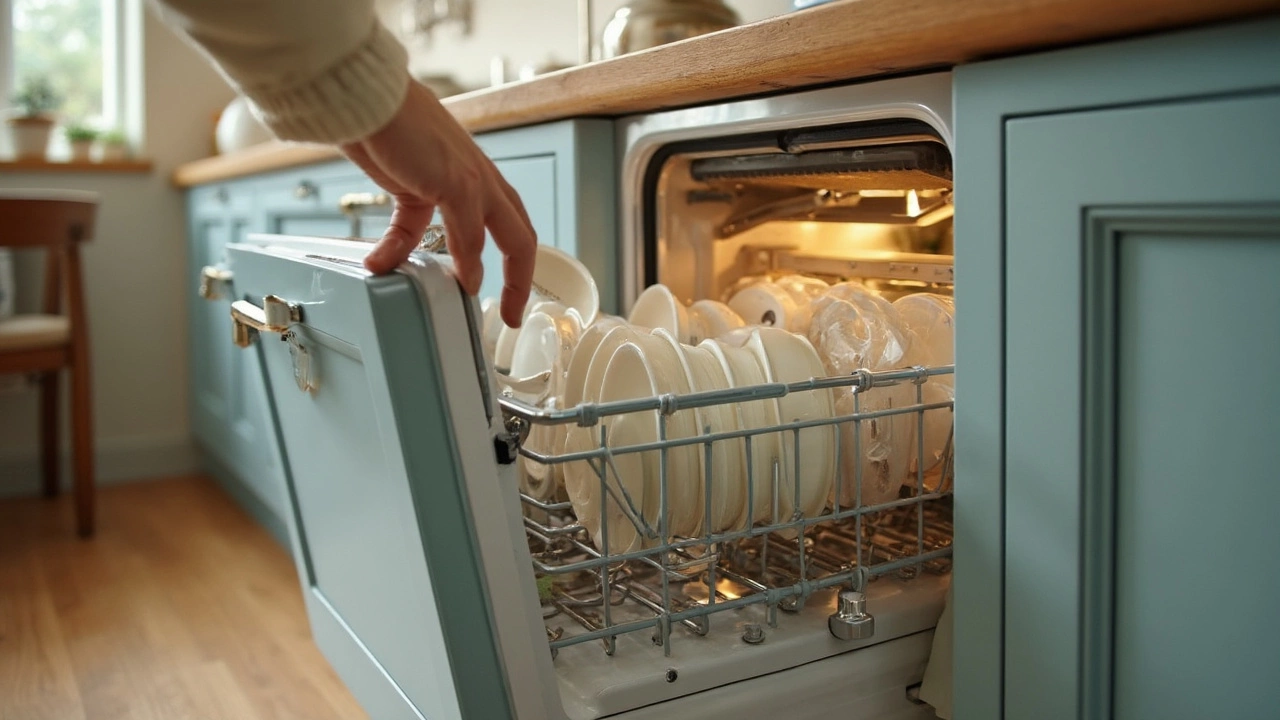So, your dishwasher isn’t acting like the reliable kitchen helper it once was. Before you consider replacing it, let's dive into some common issues these machines face and how you might fix them. Understanding these problems can not only save you a bit of cash but also keep your kitchen running smoothly.
One of the big headaches? When water doesn’t drain properly. If you’re seeing a pool at the bottom after the cycle, it could be a clogged filter or a blocked drain hose. Give those a check first before calling in the pros.
Ever pulled out a load to find dishes still grimy? You might be dealing with a problem in the spray arms or even low water temperature. Ensuring the arms can spin freely and setting the water heater right might just do the trick.
- Introduction to Dishwasher Failures
- Water Not Draining
- Dishes Not Getting Clean
- Soap Dispenser Malfunction
- Strange Noises
- Door Latch Problems
Introduction to Dishwasher Failures
Dishwashers are a wonderful convenience in the kitchen, taking the chore out of cleaning a mountain of dishes. But like all appliances, they can hit a few bumps along the way. Understanding the most common problems can be the first step to getting your trusty machine back on track without too much hassle or expense.
First up, one major issue you might face is with the dishwasher not draining properly. This often happens when the filter or the drain hose gets blocked. Filters catch food particles, and when they’re clogged, water can't pass through. Similarly, a kink or a clog in the drain hose can keep water from draining out.
Another frequent complaint is less-than-sparkling dishes. This could result from a variety of issues, like faulty spray arms, improper loading techniques, or even poor detergent choice. Making sure that water can hit all your dishes by properly placing them can be an easy fix.
Let’s not forget about the doors. Door latch problems are common. If the door doesn't close properly, the dishwasher might not start at all. Often, this is because of a misaligned latch or a seal that needs replacing.
| Common Issues | Quick Checks |
|---|---|
| Water Not Draining | Check filter and drain hose for clogs |
| Dishes Not Clean | Inspect spray arms, water temperature, detergent |
| Door Latch | Check latch alignment and seals |
Knowing these common problems not only prepares you for when they happen but also gives you the confidence to tackle them head-on. Often, it’s about spotting the issue before it turns into a bigger problem. So keep an eye out, and you could save yourself some time and possibly avoid a call to the repair service.
Water Not Draining
When your dishwasher refuses to drain properly, it's not just annoying, it's a clear sign that something's amiss. This issue can leave you with a mess at the bottom of the appliance and dishes that are less than sparkling clean. Fortunately, there are a few things you can check to solve this problem before calling in professional help.
Check the Filter
The first step in tackling a dishwasher repair due to drainage problems is to inspect the filter. Located at the bottom of the dishwasher tub, it can become clogged with food particles and debris. To clean it, simply remove the filter (consult your manual for removal instructions), rinse it under warm water, and use a soft brush to dislodge any stuck bits.
Inspect the Drain Hose
Another common culprit is the drain hose. Look for kinks or clogs in the hose that might be restricting water flow. Disconnect the hose from both the dishwasher and the sink, then check for obstructions. A simple way to clear a clog is by blowing air through it.
Cleaning the Air Gap
If your dishwasher is fitted with an air gap (the tall fixture near your sink faucet), it might be blocked. To clean it, remove the top cap and clean out any gunk. This ensures that water flows smoothly from your dishwasher to the sewer line.
Check the Garbage Disposal
If your dishwasher is connected to a garbage disposal, make sure the plug covering the drainage is removed. Sometimes, installation mistakes can lead to an unremoved plug causing drainage issues.
Common Blockage Signs
Recognize any warning signs?
- Water remains at the bottom after a cycle.
- Gurgling sounds during drainage.
- Slow drain time.
Dishes Not Getting Clean
Ever had to rerun your dishwasher because your dishes came out anything but sparkling? You're not alone. This is one of the most common dishwasher repair issues. Let's break it down.
Check the Spray Arms
These are the unsung heroes of the dishwasher world. If they're clogged or blocked by large utensils, your plates don't stand a chance. Remove any debris and make sure they're spinning freely. This simple fix could be your silver bullet.
Water Temperature Matters
Believe it or not, colder water can wreak havoc on your dishwashing dreams. Dishwashers typically rely on hot water to dissolve detergent and blast away grime. So, make sure your water heater is set between 120-150 degrees Fahrenheit for optimal results.
Loading Strategy
How you load your dishwasher can make all the difference. Overcrowding is your enemy here. Leave some breathing room and make sure pots and pans aren't blocking the detergent dispenser. It's not just about fitting everything in but giving each dish its shot at cleanliness.
Detergent and Rinse Aid
Cheap detergents might seem like a steal, but they often underperform. Stick with a recommended brand that suits your water hardness. And don’t skimp on rinse aid. It helps combat water spots and boosts drying efficiency.
Inspect the Filter
Food particles love hanging out in the filter, and if they stick around, they can land right back on your dishes. Clean the filter regularly—a quick rinse under the tap can go a long way.
Water Hardness Check
If you’ve got hard water, mineral deposits can mess up not just your dishes but your entire appliance maintenance routine. Use a dishwasher cleaner monthly to keep those pesky minerals at bay.
When these tips don’t solve your problem, it might be time to call in the experts. But usually, with a bit of tweaking, you can keep your machine running smoothly and your dishes sparkling.

Soap Dispenser Malfunction
Does your dishwasher finish a cycle only for you to find the soap still sitting in the dispenser? That's a bummer! But don't worry, you're not alone in facing this dishwasher repair issue. Let's go through some potential reasons and solutions for a malfunctioning soap dispenser.
First things first, it could be as simple as a jammed dispenser latch. This happens when dried soap or some kind of debris gets stuck. Before jumping into more complex fixes, give the latch a good clean.
Things to Check
- Debris Build-up: As obvious as it seems, check that there's no blockage. A quick wipe-down can often do wonders.
- Broken Spring: The spring mechanism in the latch could also be the culprit. If the spring isn’t working right, the dispenser can’t release the detergent. This might need a replacement part you can easily grab from a hardware store.
Installation and Door Issues
An important aspect to consider is the dishwasher’s installation. If it's not level, the door might not close properly, preventing the soap dispenser from opening. Use a spirit level to ensure everything is as it should be.
Here's another angle: In some cases, the cooling system in older dishwashers can create a vacuum effect, stopping the door from closing tight. This can lead to issues with both soap dispenser malfunctions and water drainage.
| Common Issue | Solution |
|---|---|
| Latch Blocked | Clean the latch area well |
| Spring Faulty | Replace the spring |
| Door Not Closing | Check for proper leveling |
Between checking for debris, ensuring a functional latch, and confirming proper installation, many of these common problems can be resolved without a pro. But if the problem persists, it could signify a deeper issue that a technician might need to look into. Always remember, keeping your dishwasher in tip-top shape means regular maintenance is key!
Strange Noises
Ever been startled by your dishwasher making weird sounds in the middle of the night? It’s a common concern. Most dishwashers should hum quietly, so when they start sounding like a rock concert, something’s off.
The first thing you want to check is any foreign object in the spray arms. Bits of food or even the odd fork could get trapped in there, and that’s often where that awful grinding sound comes from. Cleaning out any blockages can help. Simply remove the arms and rinse them under water, ensuring all little bits and pieces are dislodged.
Check the Pump
Another typical culprit for strange noises is the pump motor. Over time, it can become worn or clogged with debris. If cleaning the pump screen doesn’t help, a replacement might be necessary. This part can be a bit tricky, so check your machine’s manual for specific instructions or call a professional if you’re unsure.
Leveling the Dishwasher
Sometimes, vibrations and noises come down to something as simple as the dishwasher not being level. Use a spirit level to check and adjust the feet as needed. It’s an easy fix that can make all the difference.
Regular maintenance is key. Running a cleaning cycle with vinegar or a dishwasher cleaner monthly can help keep potential problems at bay. Plus, it’s always a good idea to scrape off large food particles before loading your sheets and plates.
If the noises persist, you might be dealing with a more internal mechanical issue, which usually warrants the expertise of a repair technician. Ignoring weird sounds for too long can sometimes lead to bigger, pricier problems down the line.
Door Latch Problems
Have you ever tried running your dishwasher and noticed it just isn’t starting? Before you blame everything else, check that door latch. A malfunctioning door latch can keep your dishwasher from completing its cycle because the machine will think the door is still open. It’s one of those common dishwasher repair issues that you can sometimes fix yourself.
First off, make sure there’s nothing obstructing the door’s closure. Check for any dishes sticking out or racks not sitting right. If it still won’t latch, the culprit might be the latch assembly itself. This part is crucial and ensures that the door closes securely, letting the dishwasher do its thing without leaks.
Diagnosing the Latch Issue
To diagnose, you’ll need to examine the latch mechanism. Consider these steps:
- Open the dishwasher and manually check the latch. It should move smoothly without getting stuck.
- Check the door strike plate - sometimes it’s misaligned, and simply adjusting it can do wonders.
- If you have a multimeter handy, you might want to check for continuity. If the reading is off, it’s a sure sign the latch needs replacing.
Replacing the Door Latch
If you’ve determined that a replacement is necessary, no need to worry. Replacing a door latch isn’t rocket science. Here’s a straightforward guide:
- First, make sure you unplug the dishwasher. Safety first!
- Locate the screws securing the inner part of the door. You’ll likely need to remove these to access the latch assembly.
- Once inside, disconnect the wiring harness. Be gentle—these wires can be delicate.
- Remove the old latch by unscrewing it and then fasten the new latch in place with screws.
- Plug everything back in and give it a test run. If all goes well, the latch should click nicely, and you’re set!
A little effort can help you avoid the hassle of bigger appliance maintenance issues down the line. Plus, you get the satisfaction of fixing something on your own. Win-win!


